Following a panel at Davos on deglobalisation and a flurry of comment about polycrisis, I picked up those themes in my monthly column for the FT. Thanks to my lovely editors, the piece was squeezed into the paper on Tuesday. In this newsletter I want to tease out some of the points buried in the compressed version of the op-ed. The passages in quotes are from my original draft (before editing by the FT team):
As we begin 2023, the world of economic analysis and commentary is marked by a disjuncture between discourse and data. On the one hand you have feverish talk of deglobalization and decoupling. On the other hand the statistics show an inertial continuity in trade and investment patterns.
Interestingly, this disjuncture is evident in the WEF’s own commentary on the theme and transmitted itself to our panel.
On one hand you have a headline that blares “Deglobalisation: what you need to know”. Meanwhile, the body of the WEF’s essay discusses not deglobalisation, but slowbalisation, or a plateauing of globalization.
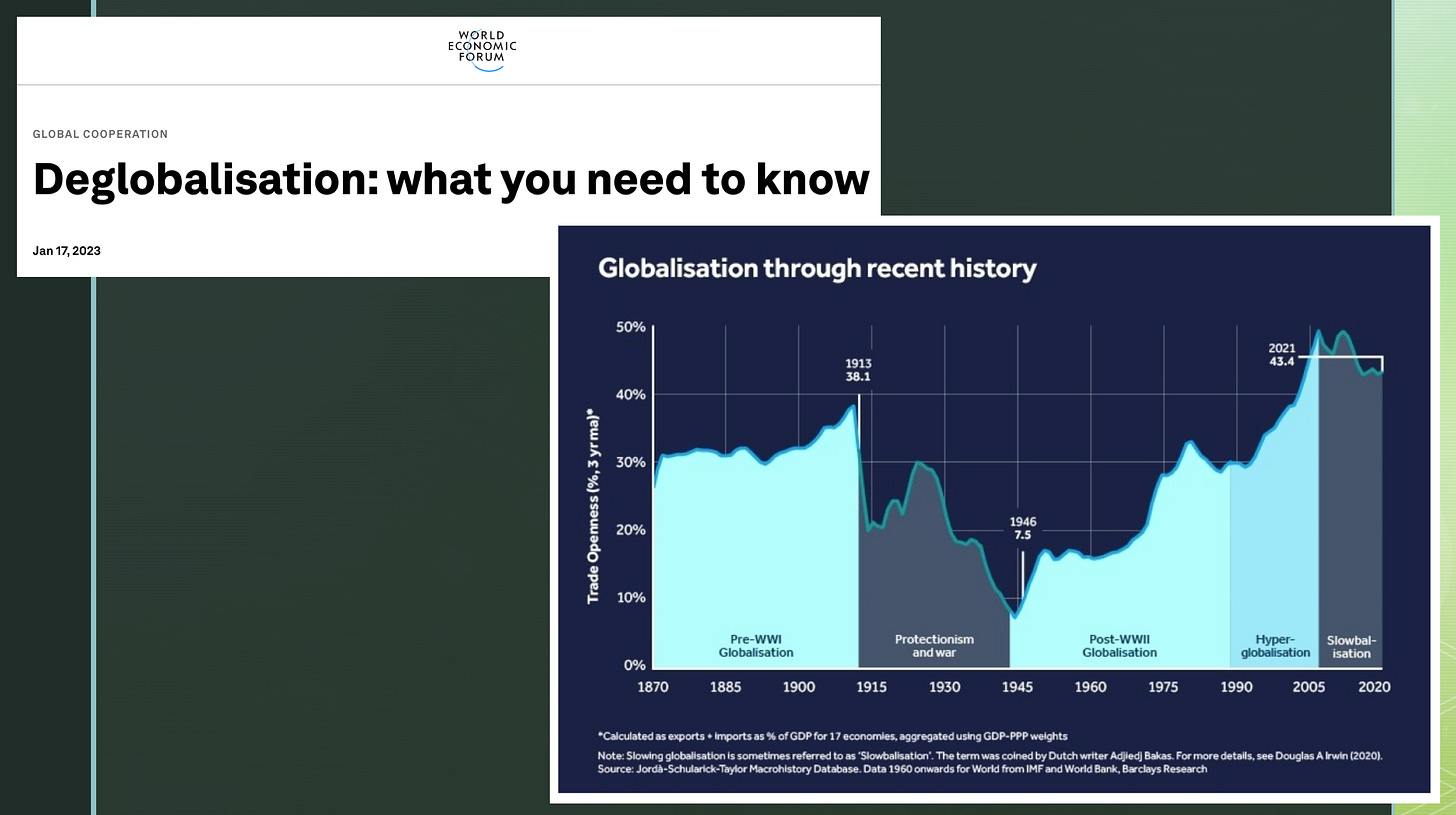
A recent report by Aiyat et al of the IMF addresses much the same confused reality and coins the new acronym – geoeconomic fragmentation (GEF).
As the IMF team make clear, the world has been transformed by globalization.
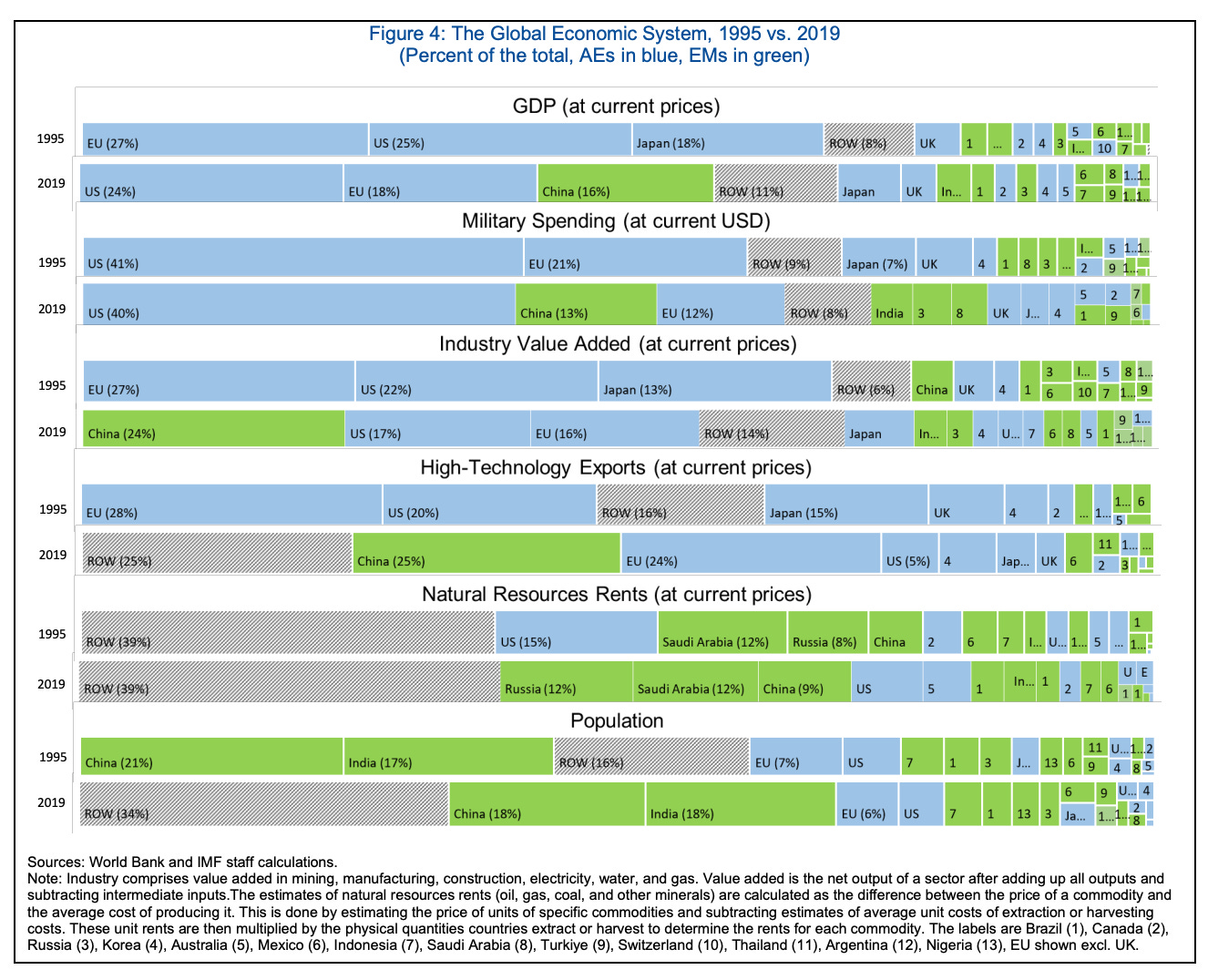
And trade trends between China and the rest of the world and between Emerging Markets hardly suggest a sudden stop to globalization. That dynamic of integration continues.
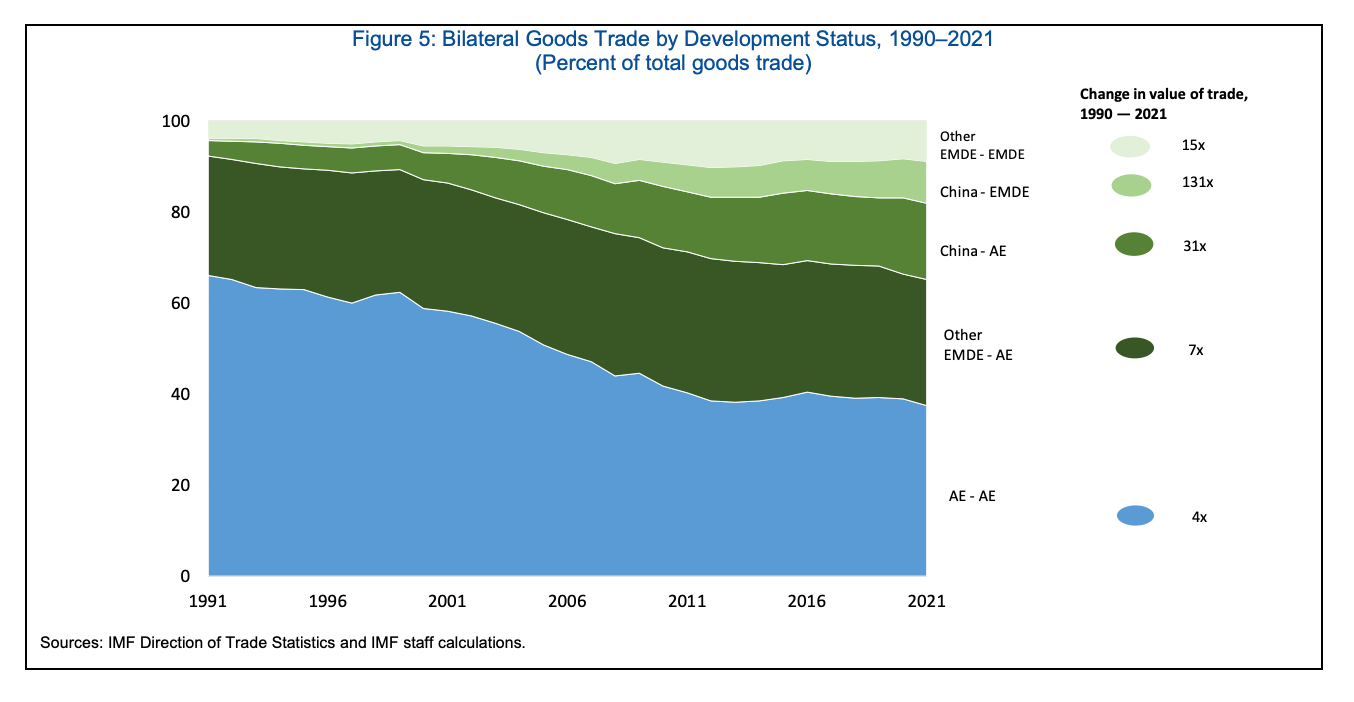
But there is an undeniable surge in anti-globalisation talk and active consideration of alternatives such as near-shoring and friend-shoring.
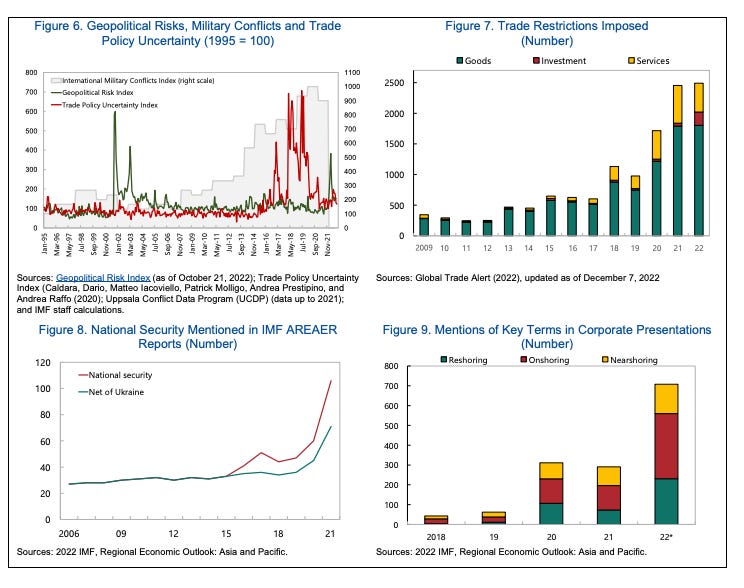
How then to reconcile this tension? My FT piece continues:
There are at least three ways to reconcile this tension. Option one: You can cleave to the old religion that economics always wins. In which case you dismiss the talk of deglobalization as journalistic hype.
You could, for instance, cite the recent FT analysis which shows just how hard it is proving for Apple to disentangle itself from its Chinese supply chains.
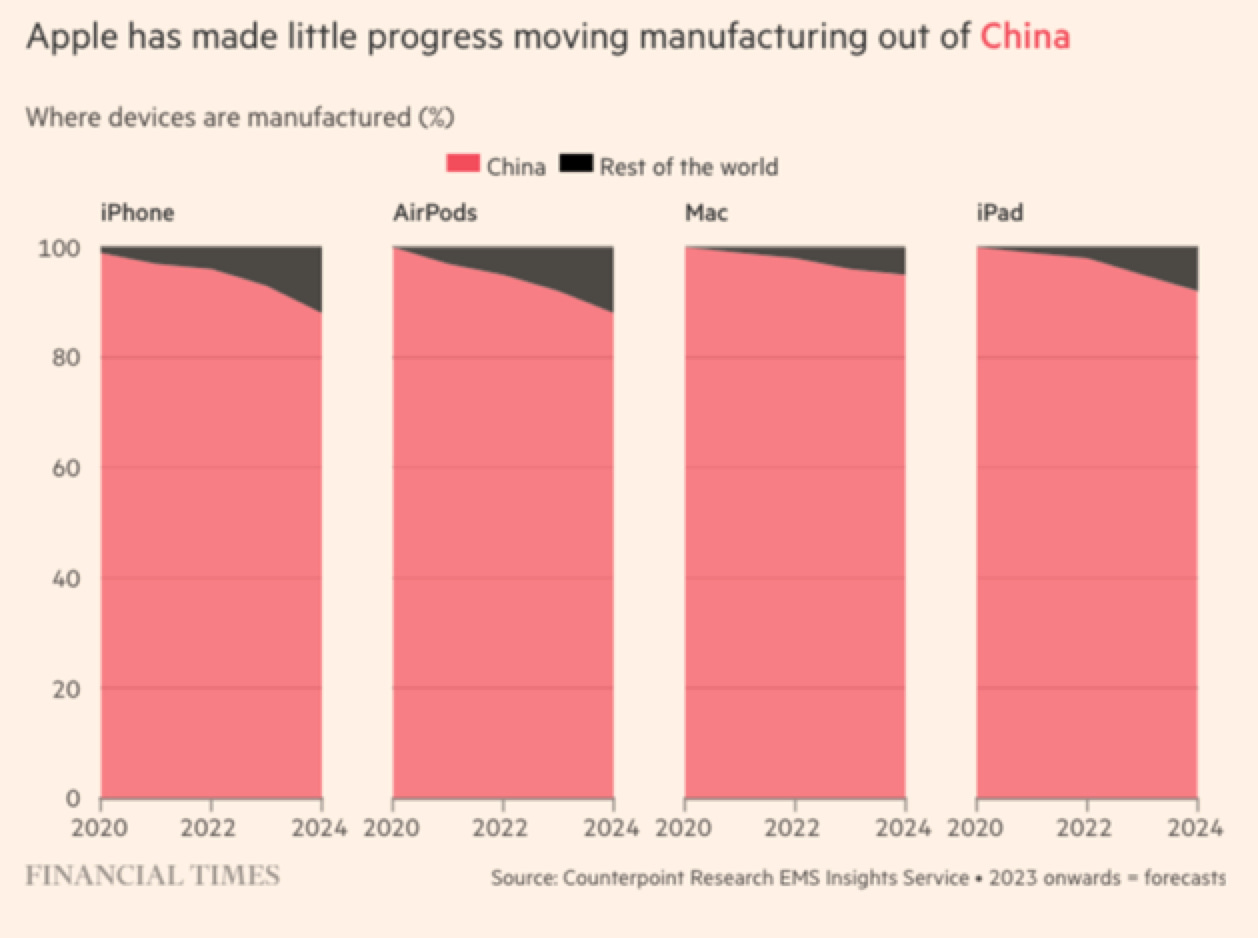
In light of the data, this debunking posture has the air of empiricism and common sense about it. But to hold this view you have, in fact, to believe many things, chief amongst them being that the Biden administration does not mean what it says.
The juxtaposition I am after is between “common sense, empiricist debunking” and the fact that this posture, in fact, rests on rather strong beliefs – an underlying theory that economics and inertia win out. Because otherwise, were you to
… take Washington seriously it is hard to avoid the conclusion that whatever the statistic tell us about the current state of affairs, the United States is bent on revising the world economic system. They intend to reprioritize domestic production and to face up to the historic challenge posed by China’s rise. And the administration is not alone in this. If there is one thing that America’s divided polity can agree on, it is the necessity to confront China.
Think about the latest round of sanctions being targeted at Huawei.
If you take this vision seriously, then you arrive at option two: rather than business as usual, we are on the cusp of a new historical epoch, a new Cold War. And this is not the Cold War of the détente era. In Washington these days even coexistence with CCP-led China is up for debate.
So here we have thesis and antithesis – economic common sense v. geopolitical and ideological confrontation.
Can this extreme tension be sustained? Or will it be resolved dialectically?
If taken at face value this is a scenario of high-stakes confrontation that overshadows every other priority, alliances, economic efficiency or civil liberties. In recent weeks there have been efforts as deescalation; first the G20 meeting between Xi and Biden, then China’s dovish appearance at Davos. But these moves do not presage a return to business as usual. Notably as far as the “chip wars” are concerned, Washington is hardening its stance.
So, if a return to “business as usual” is not on the cards, what kind of “resolution” is, in fact, on offer?
Rather than reconciliation and reconvergence, the Biden team holds out something far weirder. They do not want to stop China’s economic development, they insist, just to put a ceiling on every area of technology that might challenge American preeminence. How that is supposed to work is anyone’s guess. Imagine if China offered the USA a similar deal.
I mean this rhetorical question seriously. Imagine if China was attacking Apple’s manufacturing network, as the United States is attacking not just Huawei but the entire sector of high-tech microelectronics in China. And then imagine that Beijing blandly declared that this should not be taken as an attack on America’s economic development in general; just on the bits that matter for strategic purposes. Imagine how Washington and the American political system would react. Lingering over that scenario puts me in mind of that excellent Larry Summers op-ed from December 2018 in which he surfaces the fundamental difficulty of the American political system in accepting a shift in the balance of world economic influence.
Whether it makes sense or not, the folks in Washington are cooking up something weird. And …
… in its sheer other-worldliness it points to interpretive option number three. We are witnessing not a reversal of globalization, or full-scale decoupling, but a continuation of some aspects of familiar pattern, just on fundamentally different premises. Crucially, we are no longer in a world of peaceful convergence or level playing fields.
I started puzzling over this in earnest back in 2021, in a piece on American grand strategy triggered by the withdrawal from Afghanistan. The puzzle of what future America’s grand strategy envisions, has come only more sharply into focus since.
In the FT piece I offer the image of a patchwork:
A future world economy might be made up of a patchwork of antagonistic coalitions divided by more or less visible data curtains. States that have the resources will launch national policies like the Inflation Reduction Act, which blends green industrialization and “buy American”, with an anti-China stance and a push for friendly supply-chains. That the IRA has caused a ruckus with Europe and South Korea is not a bug. It is a feature.
Since Shutdown, I’m haunted by the emblematic quality of the vaccine story.
Perhaps a harbinger of the future is the crazy quilt of COVID vaccines: the United States driving Operation Warp Speed; the Europeans trying to broker a complex bargain that includes exports to the rest of the world; India as a manufacturing hub; China pursuing an inadequate national solution; and one third of the world’s population excluded altogether.
Here is the global COVID-vaccine map as of last week:
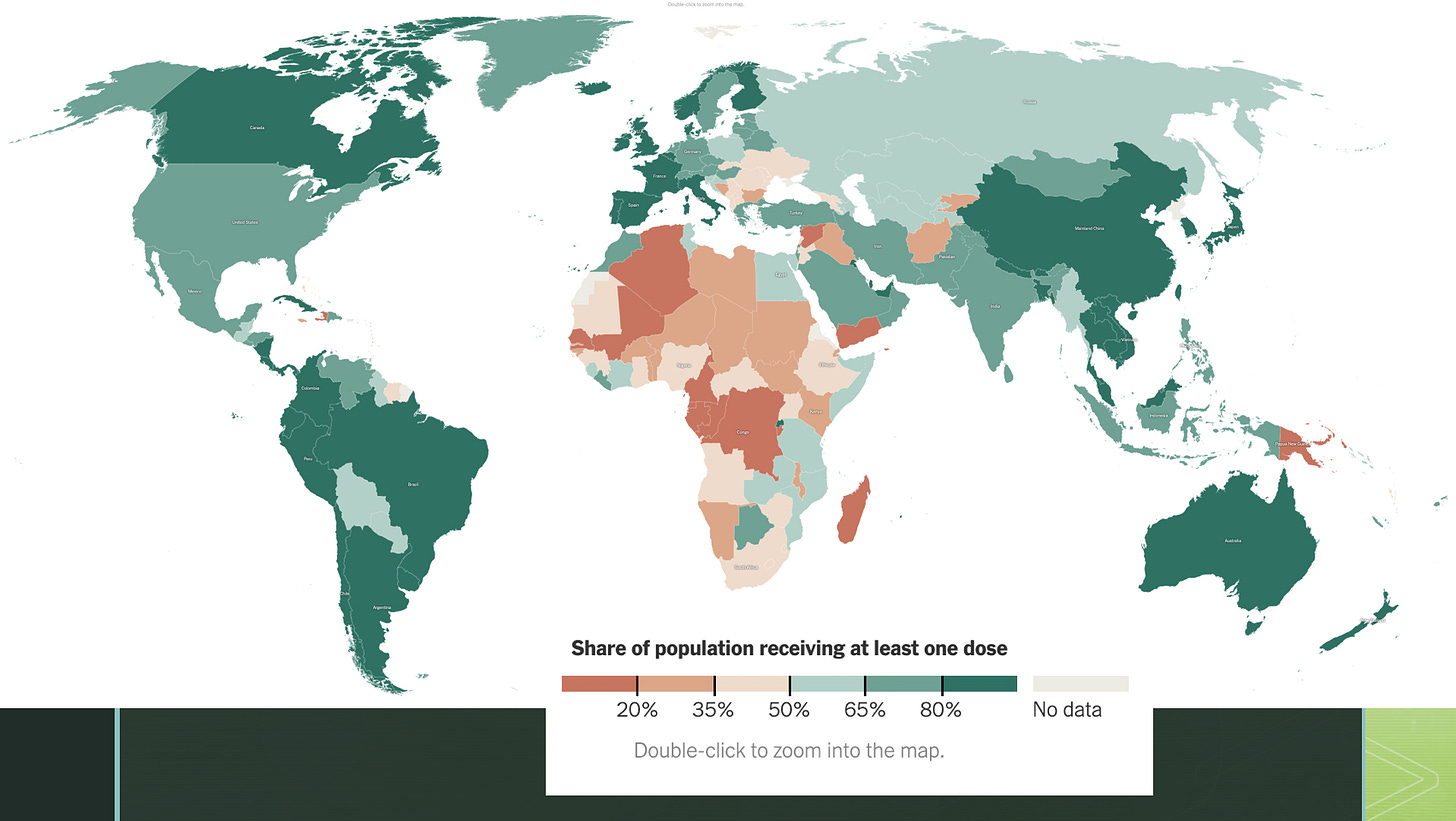
As we know, the unequal production and distribution of vaccines was propelled by the policy of the big economic blocs. But it was dependent on global supply chains and has resulted in a highly uneven delivery of COVID-protection.
You might shrug and ask whether this mélange of geopolitics, economic nationalism and the occasional pandemic is really new. Is it not just “history” as we have always known it – unpredictable and red in tooth and claw?
This was Ferguson’s comment on the WEF panel. It is superficially persuasive and was taken up by Dan Drezner in his Vox column on polycrisis. But it is, of course, profoundly question-begging.
When you say, all this talk about polycrisis is “just history”, what exactly do you mean by “history”? The perplexity is only made greater by the throwaway “just”. Once again a seemingly obvious bit of common sense trails behind it a mess of intellectual baggage.
The point was grasped very clearly by Larry Summers in his embrace of the polycrisis concept.
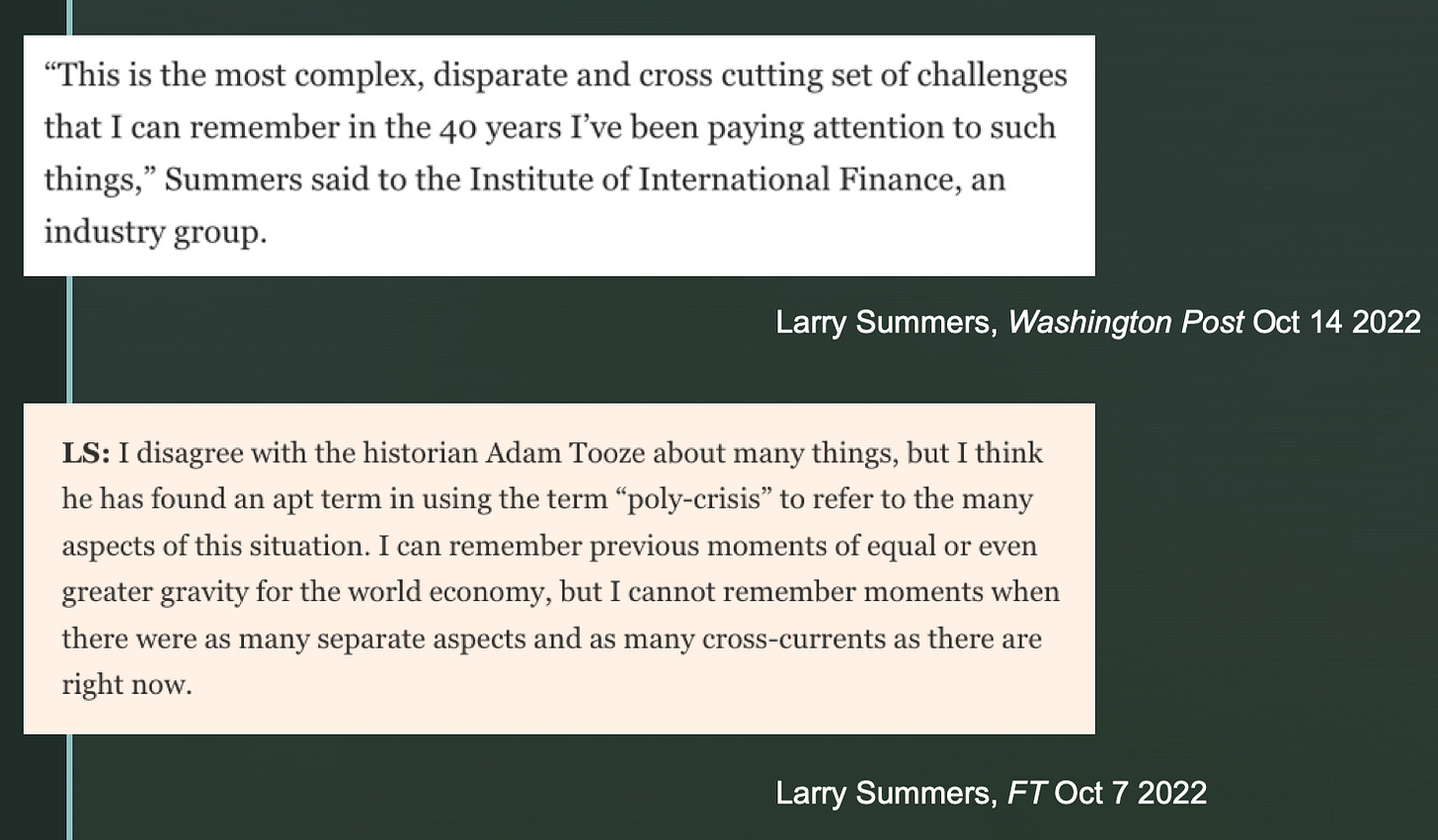
What polycrisis refers to, is the abnormal coincidence of disparate shocks. Of course, to be able to characterize shocks as abnormally disparate you need to have some conception of development that doesn’t satisfy itself by waiving heartily to “just history”. You have to make some assumptions about which kinds of shocks are to be expected and which not.
A concept of polycrisis that is not merely redundant must rest on a more or less explicit philosophy of history.
As Bo Harvey has noted in a truly interesting intervention in the discussion, Marxism provides one obvious framework within which to situate the polycrisis debate. And as Harvey notes that begs the question of exactly what conceptual work is going to be done by the concept of capitalism. This will require much further elaboration.
Meanwhile, Drezner and Noah Smith have not been shy about basing their critique of the polycrisis idea on their own preferred historical theories. Those theories are of the homeostatic, self-equilibrating variety. When they see a shock they look for a negative feedback loop.
What they take issue with is precisely what Harvey so well describes.
‘polycrisis’ in a strict sense would mean not simply the adding together of different crises and treating them as one (the ‘there’s lots of things going on’ definition), but rather a system that is ‘emergent’ out of their interaction and interrelation—a crisis greater than each specific crisis added together. A world subsumed by polycrisis becomes a kind of nightmarish ‘emergent system,’ the roots of which are irreducible to a single cause, thus the necessity of those maps and charts best captured by Krisenbilder (“crisis pictures”).
Drezner and Smith, by contrast, insist on the force of a variety of countervailing and self-equilibrating forces. Clearly, a polycrisis interpretation must be premised on something more open-ended and less complacent. Something more Keynesian, for instance – think multiple bad equilibria with involuntary unemployment – and a growth path steered by repeated crisis-management.
At this point you may be wondering what this long diversion has to do with the topic at hand: the question of globalisation. The connection is the underlying theory of history implied by talk of globalisation.
Globalisation is more than merely a set of mute economic processes. It was a process tied to, energized by and framed by institutions that were shaped by a narrative, a teleological narrative of growth, interconnection and convergence. And this means that you cannot have it both ways. You can’t simultaneously insist that polycrisis is really no more than history in its “normal” disturbed and violent form and that globalization is proceeding as per normal. I don’t think that 1914 is a good point of comparison for our current moment, but if you do go there, as Drezner does, you at least have to do some work to suggest how globalization might be modified by such a confrontation, as Ted Fertik and I did back in 2014. Otherwise, if you blithely dismiss polycrisis as “just history happening”, you are, in fact,
… giv(ing) the game away. The promise of globalization, as it was understood from the 1990s onwards, was precisely that it would usher in a new era. It (globalization) was the dynamic underpinning of the end of history thesis.
Globalization talk, in other words, offers its own philosophy of history, a strong and teleological one.
So to admit not only that a scatter shock of unexpected and diverse shocks is disrupting the world economy, but that they are multiplying and becoming more intense, is, in fact, to admit a fundamental disappointment of expectations.
The polycrisis concept – as seized upon by Summers – registers that shock and thus offers a kind of dialectical “resolution” – admittedly of a weak kind.
Whereas the advocates of “business as usual” declare that it is still “the economy stupid” and the new Cold Warriors rally around the banner of “democracy versus autocracy”, the third position faces the reality of confusion, the kind of confusion registered by a term like polycrisis.
The concept of polycrisis serves as the third moment in the dialectic (thesis-antithesis-synthesis), not because it offers a strong concept of a new world, or a clean break with the past motivated by what is retrospectively reconstructed as a single dominant tension (autocracy v. democracy). Rather the polycrisis concept offers a form of (weak) dialectical resolution precisely because it refuses to flatten the thirty-year switchback of optimism and disillusionment with the steamroller of “just history”. Instead, it retains and makes explicit the sense that our present moment is overshadowed by disappointment and confusion.
Polycrisis, for me, does the work of Aufhebung (sublation). In fact, if you google the term Aufhebung, google yields an image which, though twee, captures a further, for me, important feature of the polycrisis concept.

Not only does polycrisis describe a messy situation and register our surprise and dismay at the degree of the confusion. It is a concept that was itself found amongst the wreckage – in Jean Claude Juncker’s musings about the EU’s situation in 2015/6. It is a “found concept”, an idea “picked up” off the intellectual sidewalk and deposited in our conceptual carrier bag.
What does this found concept do?
Polycrisis has its critics and at Davos 2023 it risked becoming something of a cliché. But as a catchword it serves three purposes. It registers the unfamiliar diversity of the shocks that are assailing what had previously seemed a settled trajectory of global development. It insists that this coincidence of shocks, whether economic, geopolitical, climatic or epidemiological, is not accidental but cumulative and endogenously self-amplifying. And, by its currency, it indexes the moment at which bullish self-confidence about our ability to decipher either the future or recent history has begun to seem at the same time facile and passé.
Only if we stop reducing the radical and unprecedented situation facing us, either with rewarmed ideological polarities – autocracy v. democracy – or the intellectual bludgeon of “just history”, do we have any hope of making sense of our circumstances and of actually thinking in medias res.
***
Thank you for reading Chartbook Newsletter. It is rewarding to write. I love sending it out for free to readers around the world. But it takes a lot of work. What sustains the effort are voluntary subscriptions from paying supporters. If you are enjoying the newsletter and would like to join the group of supporters, click here:
